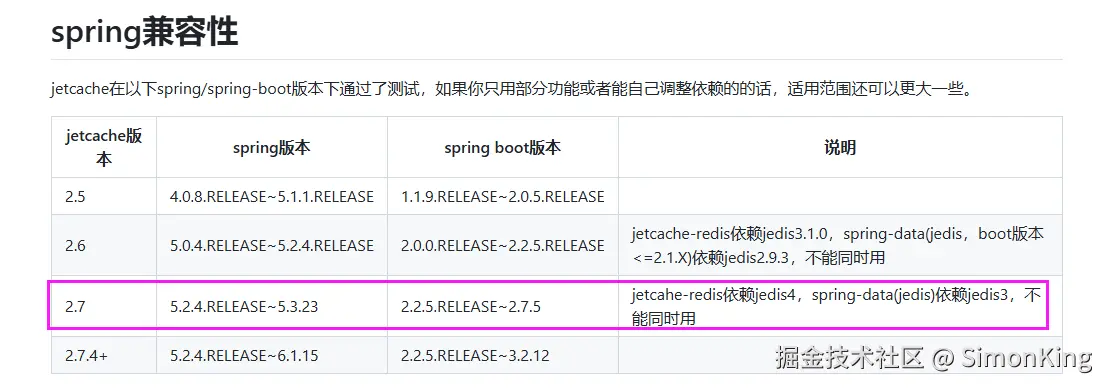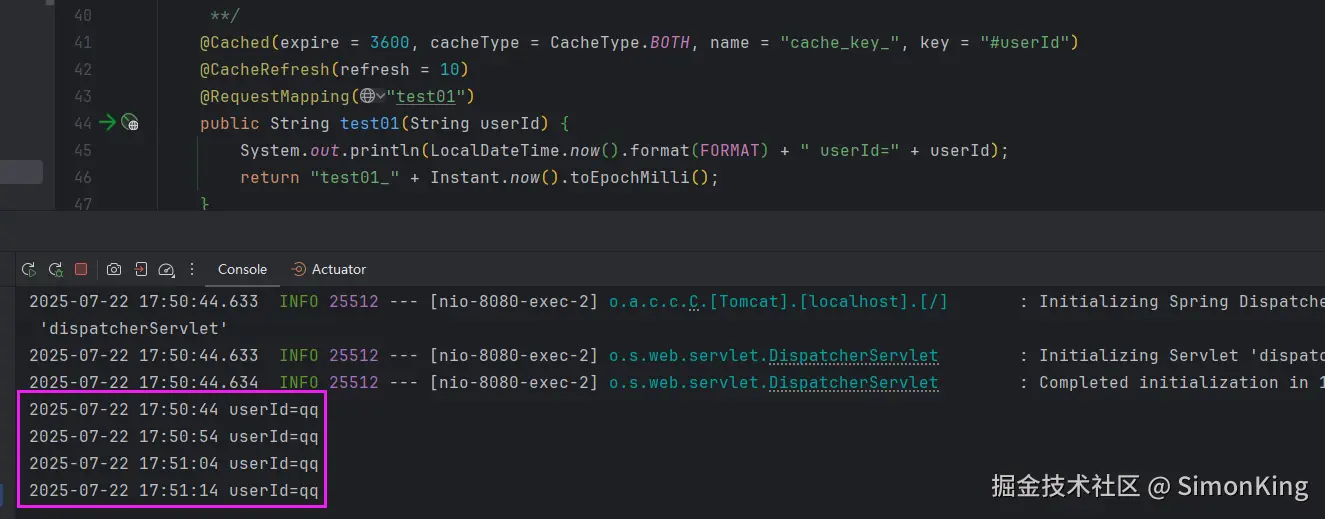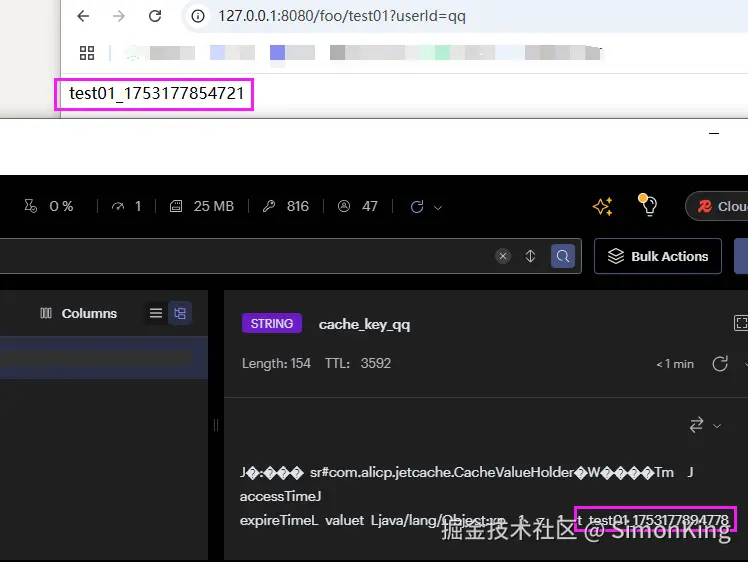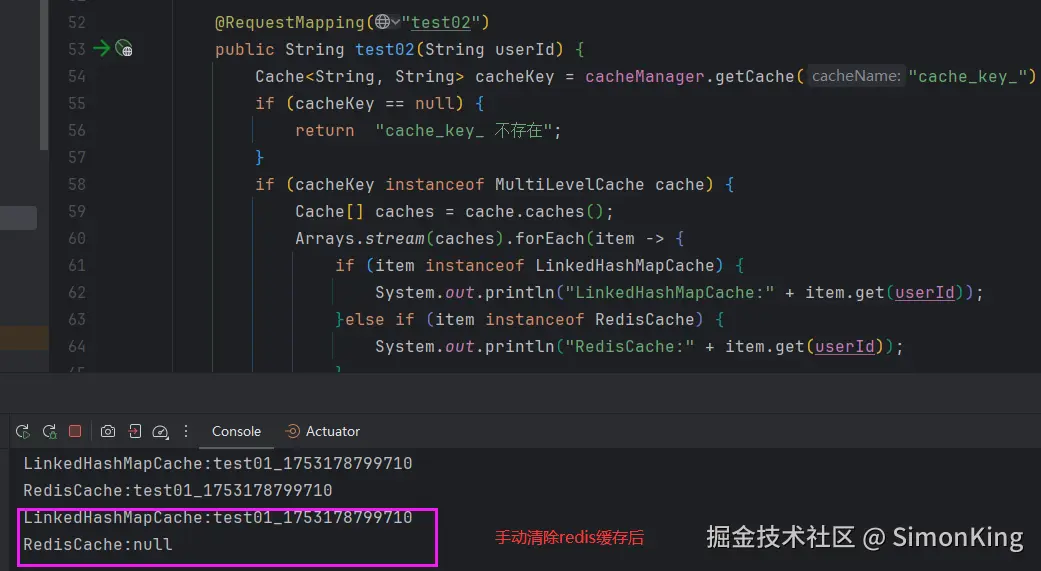关注我的公众号:【编程朝花夕拾】,可获取首发内容。

01 引言
上一节介绍了本地缓存相关的使用以及坑点,本地缓存的使用往往带有局限性,用的更多的依然还是类似Redis这样的分布式缓存。
阿里巴巴出品的JetCache正是整合了本地缓存和分布式缓存,由框架自动管理本地缓存和远程缓存。提供了注解驱动的声明是缓存,同时也提供缓存的管理器CacheManage,可以随时手工接管缓存的使用。
我们一起来了解一下吧!
02 JetCache简介
JetCache 是一个 Java 缓存抽象框架,为不同缓存解决方案提供统一使用方式,其注解功能比 Spring Cache 更强大。它支持原生 TTL、两级缓存、分布式环境下自动刷新,还能通过代码操作缓存实例。
当前有 RedisCache、TairCache(未开源)、CaffeineCache 和 LinkedHashMapCache 四种实现。其具备多种特性,如通过统一缓存 API 操作缓存、支持带 TTL 和两级缓存的注解式方法缓存、可创建及配置缓存实例、自动收集缓存访问统计信息、自定义键生成和值序列化策略、支持多种缓存键和值转换器、分布式缓存自动刷新和分布式锁、异步访问、更新后使本地缓存失效以及 Spring Boot支持等。
环境要求:
- JDK1.8
- Spring Framework4.0.8+ (optional, with annotation support),jetcache 2.7 need 5.2.4+
- Spring Boot 1.1.9+ (optional), jetcache 2.7 need 2.2.5+
Github地址:github.com/alibaba/jet...
03 使用案例
3.1 Maven
案例基于Spring Boot 2.6.13
xml
<dependency>
<groupId>com.alicp.jetcache</groupId>
<artifactId>jetcache-starter-redis</artifactId>
<version>2.7.8</version>
</dependency>
<dependency>
<groupId>redis.clients</groupId>
<artifactId>jedis</artifactId>
<version>4.4.3</version>
</dependency>jetcache-starter-redis默认使用的是Jedis客户端。因为jetcache-starter-redis 2.7.8和Spring Boot 2.6.13有冲突,需要引入Jedis 4.x版本。

否则就是出现部分类找不到的现象:

3.2 配置文件
properties
jetcache.statIntervalMinutes=15
jetcache.areaInCacheName=false
#还可以选caffeine
jetcache.local.default.type=linkedhashmap
#还可以选fastjson/fastjson2
jetcache.local.default.keyConvertor=jackson
jetcache.local.default.limit=100
jetcache.remote.default.type=redis
#还可以选fastjson/fastjson2
jetcache.remote.default.keyConvertor=jackson
#还可以选kryo/kryo5
jetcache.remote.default.valueEncoder=java
#还可以选kryo/kryo5
jetcache.remote.default.valueDecoder=java
jetcache.remote.default.poolConfig.minIdle=5
jetcache.remote.default.poolConfig.maxIdle=20
jetcache.remote.default.poolConfig.maxTotal=50
# 集群配置
jetcache.remote.default.cluster[0]=127.0.0.1:7000
jetcache.remote.default.cluster[1]=127.0.0.1:7001
jetcache.remote.default.cluster[2]=127.0.0.1:7002JetCache的配置并没有提示,所以配置的时候要注意,防止配错。
详细的配置说明:github.com/alibaba/jet...
启动类的注解
@EnableMethodCache(basePackages = "xx.xx.xx")
3.3 注解使用案例
注解可以加在接口上,也可以加在类上。案例以在类上使用为例。
常用注解:
@Cached@CacheUpdate@CacheInvalidate@CacheRefresh
@Cached 和 @CacheRefresh
java
/**
* @Description: 新增/刷新缓存
*
* @Author: ws
* @Date: 2025/7/22 13:45
**/
@Cached(expire = 3600, cacheType = CacheType.BOTH, name = "cache_key_", key = "#userId")
@CacheRefresh(refresh = 10)
@RequestMapping("test01")
public String test01(String userId) {
System.out.println(LocalDateTime.now().format(FORMAT) + " userId=" + userId);
return "test01" + Instant.now().toEpochMilli();
}代码注意事项:
CacheType.BOTH表示同时使用本地缓存和远程缓存,这里可以指定任意一个缓存使用。- 属性中
name和key的拼接组成Redis中的key key使用的是EL表达式,通过#取属性的值@CacheRefresh的refresh指每隔多长时间刷新一次缓存
缓存更新效果

再次请求缓存已经更新

@CacheUpdate
java
/**
* @Description: 更新缓存
*
* @Author: ws
* @Date: 2025/7/22 13:45
**/
@CacheUpdate(name = "cache_key_", key = "#userId", value = "#val")
@RequestMapping("test03")
public String test03(String userId, String val) {
return "缓存更新成功!";
}这里要说明的更新的value的值也是通过EL表达式从参数中获取的,无法指定方法中的数据作为缓存的结果
@CacheInvalidate
java
/**
* @Description: 更新缓存
*
* @Author: ws
* @Date: 2025/7/22 13:45
**/
@CacheInvalidate(name = "cache_key_", key = "#userId")
@RequestMapping("test04")
public String test04(String userId) {
return "缓存失效!";
}这里值得注意的是,这里的缓存失效,会将远程的缓存失效以及本机的缓存失效,其他节点的本地缓存并不能同步失效。
3.4 手动API接管
java
@Autowired
CacheManager cacheManager;
@RequestMapping("test02")
public String test02(String userId) {
Cache<String, String> cacheKey = cacheManager.getCache("cache_key_");
if (cacheKey == null) {
return "cache_key_ 不存在";
}
if (cacheKey instanceof MultiLevelCache cache) {
Cache[] caches = cache.caches();
Arrays.stream(caches).forEach(item -> {
if (item instanceof LinkedHashMapCache) {
System.out.println("LinkedHashMapCache:" + item.get(userId));
}else if (item instanceof RedisCache) {
System.out.println("RedisCache:" + item.get(userId));
}
});
}
return cacheKey.get(userId);
}效果

3.5 命中率统计
JetCache自带了统计功能,每隔一段时间就会输出统计数据。通过jetcache.statIntervalMinutes配置控制

04 关键注意事项
因为结合本地缓存和远程缓存,那么框架就存在这两者的优势和劣势。使用的时候也需要注意:
- 缓存防止大
Key的出现 - 本地缓存需要增加容量限制
- 结合TTL和主动失效
- 多节点本地缓存不同步的问题
- 使用时
Spring Boot、Jedis、JetCache版本兼容问题
05 小结
通过合理利用JetCache的同步机制和缓存策略,可显著提升系统性能并保障数据一致性。建议结合具体业务场景进行参数调优,并持续监控缓存健康度。
使用任何一个框架,我们也要考虑可能带来的问题。线下发现不了,线上就会教会我们了。